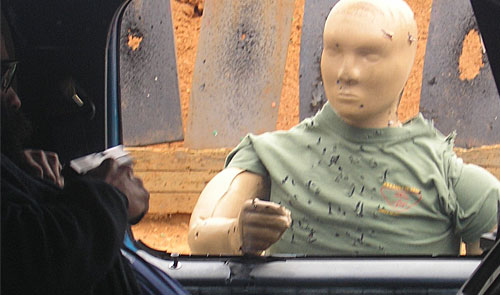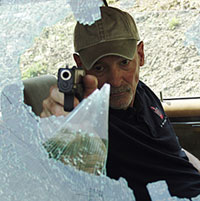
There is a trend for instructors to create their own definitions of particular words to support their lesson plan or doctrine. I don’t think there’s anything wrong with this, but I prefer to refer to my old coverless, dog-eared, worn out, paperback (I know…old school) version of the Webster’s Dictionary for such info.
Awhile back, after hearing a number of students complain about spending too much time working on shooting fundamentals, I looked into “the book” to see exactly what the word fundamental meant. What I found is “forming a foundation or basis; basic; essential”. Essential!? Wow, that certainly sounds important and it led me to seek out the meaning of essential: Absolutely necessary; indispensable –n. something necessary or fundamental.
Let me make this perfectly clear so there is no misunderstanding…shooting fundamentals are absolutely necessary…they are indispensable… in other words they are essential!! One’s ability to grip the gun, control the trigger, present from various positions or the holster, manipulate or clear are non-negotiable. While they might not be as fun as “advanced” skills (you know…high speed, low drag, etc.), it would be wise to remember what Bruce Lee said almost 40 years ago… advanced skills are the basics mastered. I wish I had a nickel for every complaint I have heard while spending time in class to try and anchor these essential skills. Phrases like “They’re boring!” or “We’ve done these before!” are often heard but just because you have done them before does not mean you are good at them. My response is usually something like “Yes you have done these before…you have certainly experienced these skills in the past…the problem is you suck at them, Scooter!”
The goal behind instruction followed by practice is to absorb and then master a particular skill, to try and anchor it in one’s skill set (I’m worn out on “tool box”) as best as time will allow. Just because one can perform a particular essential does not mean they perform said skill well enough to save their life, thus we continue to practice. The brain is a funny thing, it can remember doing something in the past, but the brain leaves out the part where it takes five or six seconds to complete the given act which is tactically unacceptable. Lt. Frank McGee, the former head of the NYPD Firearms Training Unit, once said armed conflict involving police could be broken down to a Rule of Three…three rounds, three yards, three seconds and it would not be a stretch to apply this to armed citizens. Don’t confuse this with a range drill as one of my former editors did. When I wrote an article about the Rule of Three he stated, “Anyone should be able to shoot three rounds at three yards in three seconds” and changed the article to two rounds in two seconds. Obviously this computer Ninja missed the point.
The point is armed conflict, especially involving a handgun, is close, fast and over quickly with one or more people down, possible dead… something my former editor missed. Someone shooting back at you changes everything which is why essential skills must be practiced to the point of “auto pilot”. There will be no time to sort out or “orient” to what is transpiring, you will either rise to the occasion or you will not and the history of armed conflict has shown the person who can go from observation to action the quickest will usually prevail regardless of how tight a group they can shoot.
The essentials are, well…ESSENTIAL to fight instantly along with a cool head and commitment to the task but then we have known for a long time the person who has confidence in their skills will better control fear and fight hard in conflict. Have you practiced your essential skills to the point required for such a high level of confidence in pandemonium?
A dose of harsh reality is in order… there is no way to prepare for every potential situation you may face in a gun fight. It just can’t be done as the variables are too great, but that does not mean you can’t prepare. The truth is, armed conflict is situationally dependent on terrain, weather, number of combatants, what happens during the fight itself, skill level and commitment of the combatants just to name a few. The person who can best adapt their essential skills to the fight will likely prevail. For example, you are sitting in a car when the fight breaks out, how different is drawing from a seated position in a vehicle than standing on the range? The physical action is similar, but the shooter must lean forward to make room in the seat for the arm to move back, clear the steering wheel and either shoots out the window or through the windshield. It is the same but different, if you see what I mean. The draw stroke must be adapted to the situation at hand.
I teach a course called Situational Combative Pistol through my training company Handgun Combatives LLC (www.handguncombatives.com) that addresses this very issue of adapting essentials to varied situations. I originally called it Adaptive Pistol but once Travis Haley came out with his exceptionally well done video of the same name (www.panteoproductions.com) I changed it so folks would not think I was stealing his title. By the way, I highly recommend all of the videos in the Panteo line as all are very well done and are full of worthwhile information.
OK, enough of the commercial…train the essentials on the range with the thought you will have to shoot in varied positions. Practice seated, on the ground, from behind objects, on stairs, in hallways, rain, snow, etc. This does not have to be on a range but can be accomplished in your home via dry fire or in like and similar environments with Airsoft…be innovative! “War game” scenarios in your head or from actual events reported on line or in the news and work them out, recreate them or even develop solutions while practicing. All of this will better prepare you for the fight of your life…or for your life.
About the author:
 Dave Spaulding is the 2010 Law Officer Trainer of the Year and Law Officer’s Firearms columnist. A 36-year law enforcement and private security veteran, he retired at the rank of lieutenant. He is the founder of Handgun Combatives a training institution that focuses on the combative application of the handgun. He has worked in corrections, communications, patrol, evidence collection, investigations, undercover operations, training and SWAT—and has authored more than 1,000 articles for various firearms and law enforcement periodicals. He is also a graduate of most of the nation’s best known shooting schools. He’s also the author of the best-selling books Defensive Living and Handgun Combatives. Visit his web site at www.handguncombatives.com and like him on Facebook. His DVDs “Handgun Combatives are also available on Paladin Press.
Dave Spaulding is the 2010 Law Officer Trainer of the Year and Law Officer’s Firearms columnist. A 36-year law enforcement and private security veteran, he retired at the rank of lieutenant. He is the founder of Handgun Combatives a training institution that focuses on the combative application of the handgun. He has worked in corrections, communications, patrol, evidence collection, investigations, undercover operations, training and SWAT—and has authored more than 1,000 articles for various firearms and law enforcement periodicals. He is also a graduate of most of the nation’s best known shooting schools. He’s also the author of the best-selling books Defensive Living and Handgun Combatives. Visit his web site at www.handguncombatives.com and like him on Facebook. His DVDs “Handgun Combatives are also available on Paladin Press.




